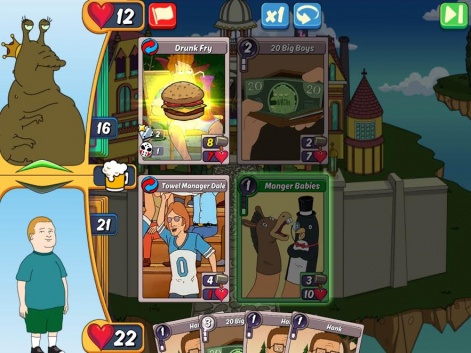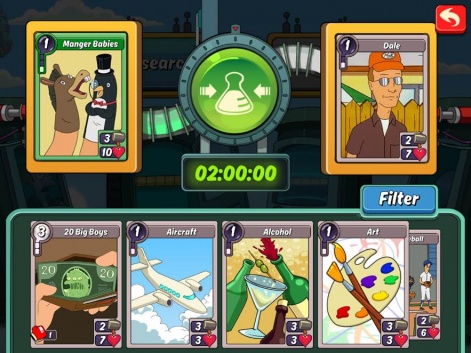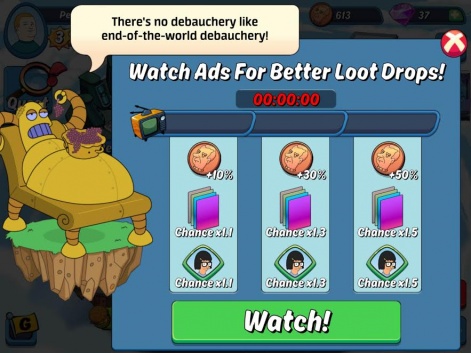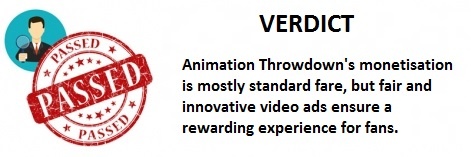Welcome back to the In-App Purchase Inspector - our regular look at free-to-play games from the consumer's perspective.
In each instalment, we consider the incentives or pressure applied to make in-app purchases, their perceived value, the expansion offered by IAPs and the overall value of the experience.
The end goal is to see whether the game makes a good enough case for us to part with our cash, or if players are content - or engaged enough - to 'freeload'.
This time, we're taking a look at Fox and Kongregate's cartoon mash-up CCG, Animation Throwdown.
A strong hand
With user acquisition an increasingly big, expensive headache for mobile game developers, opting to leverage brands with an existing fanbase to alleviate this is no new strategy.
If one IP can boost your game to the top of the App Store, then how about five?
But if one IP can boost your game to the top of the App Store, then how about five? This seems to be the thinking behind Animation Throwdown: The Quest for Cards, a new Kongregate-published CCG that uses five of Fox's animated comedy brands.
These are Futurama, King of the Hill, Family Guy, Bob's Burgers, and American Dad.
The firm has also taken the same 'more is more' approach behind the scenes, with Kongregate, Synapse Games, and Chinzilla Games all co-developing the title.
Kongregate being a Gamestop company, Animation Throwdown: The Quest for Cards also has the rare luxury of in-store promotion across 4,200 US retail store locations.
Familiar faces
Between a quintuple brand threat and this kind of promotion, it's little surprise that the game is performing well when it comes to downloads, thus far peaking at #2 in the US App Store Games Downloads charts.
But how does it monetise and retain its players once it's got them?
First off, Animation Throwdown leads with the characters. Now this is nigh-on essential for any collectible card game, but especially so for one that's so built around recognisable brands.

And indeed, the game finds itself in the difficult position of having to offer compelling strategy, but make it accessible for a casual Family Guy fan who might never have played a CCG before.
It handles this smartly, by building the core of the gameplay (and monetisation) around fan service.
It builds the core of the gameplay (and monetisation) around fan service.
Essentially, there are two types of cards: characters and other, seemingly random items or concepts. Examples include Art, Aircraft, Weapon, and School.
Combining these in play creates an alternate version of the character in question, which references an event from the TV series.
Shut up and take my money!
The significance of this is that, with the actual card-based gameplay relatively simple, it's these combinations that provide the most value - especially for the die-hard fans to whom Kongregate is appealing.
Of course, a key pillar in monetising this is the purchasable card packs.
These range from 1,000 Coins (soft currency) for one random card to 900 Gems (hard currency, worth approximately $10.90) for six cards, two of which are guaranteed to be high-value Epics.
Not all character and card combinations are available immediately, however, with many requiring research first. The time this takes depends on the rarity of the combination - could be 15 minutes, could be two hours.

A nice touch is that you're given two slots for this as standard, meaning you can research two pairs simultaneously. A surprising omission, though, is that a third or even fourth are not unlockable via IAP.
You'd think that these would be incredibly popular, in the same way that the third builder is almost a compulsory early purchase for anyone serious about Clash of Clans.
Much of Animation Throwdown's monetisation is straight from the CCG playbook.
But perhaps Kongregate concluded that this would result in player burning through all research combinations too quickly. Or simply that the Gem cost to skip wait timers would be ultimately more profitable.
I like those odds
In truth, however, much of Animation Throwdown's monetisation is straight from the CCG playbook.
The only real gripe would be that the basic card pack, with its one random card for 1,000 coins, is a slightly meagre offering given the fact it's the only pack you can access without spending on gems.
Much more interesting, however, is the game's treatment of in-game video ads.
The obvious route here would be to offer a basic rewarded ad system - offering perhaps some soft currency, or a card, in return for watching a video ad.
Instead, Animation Throwdown's system offers better loot drops for those who watch the ads, with your chance of earning valuable cards increasing 10% with one ad, 30% with two, and 50% with three.

The idea of offering a rewarded ad system where the rewards are intangible may seem odd initially, but in practise it's a smart move.
For one, the established rewarded ad system is a dead-end; you get your reward and you're free to leave. In this system, players are encouraged to keep playing in order to maximise spoils.
Furthermore, it makes it clear that you're missing out if you don't watch the ads, thus heavily encouraging repeated engagement with the adverts.
Cards on the table
So while Animation Throwdown: The Quest for Cards may not be the deepest or most innovative collectible card game on mobile, its monetisation largely hits the right notes for its audience.
Its decision to do more to characterise its cards with cute references makes them infinitely more desirable to a series fan, which ties into the research metagame.
And the incentivised video ad system is the cherry on top, simultaneously offering good value to the player and targeting the large majority of its casual player base who are unlikely to spend a penny.





















